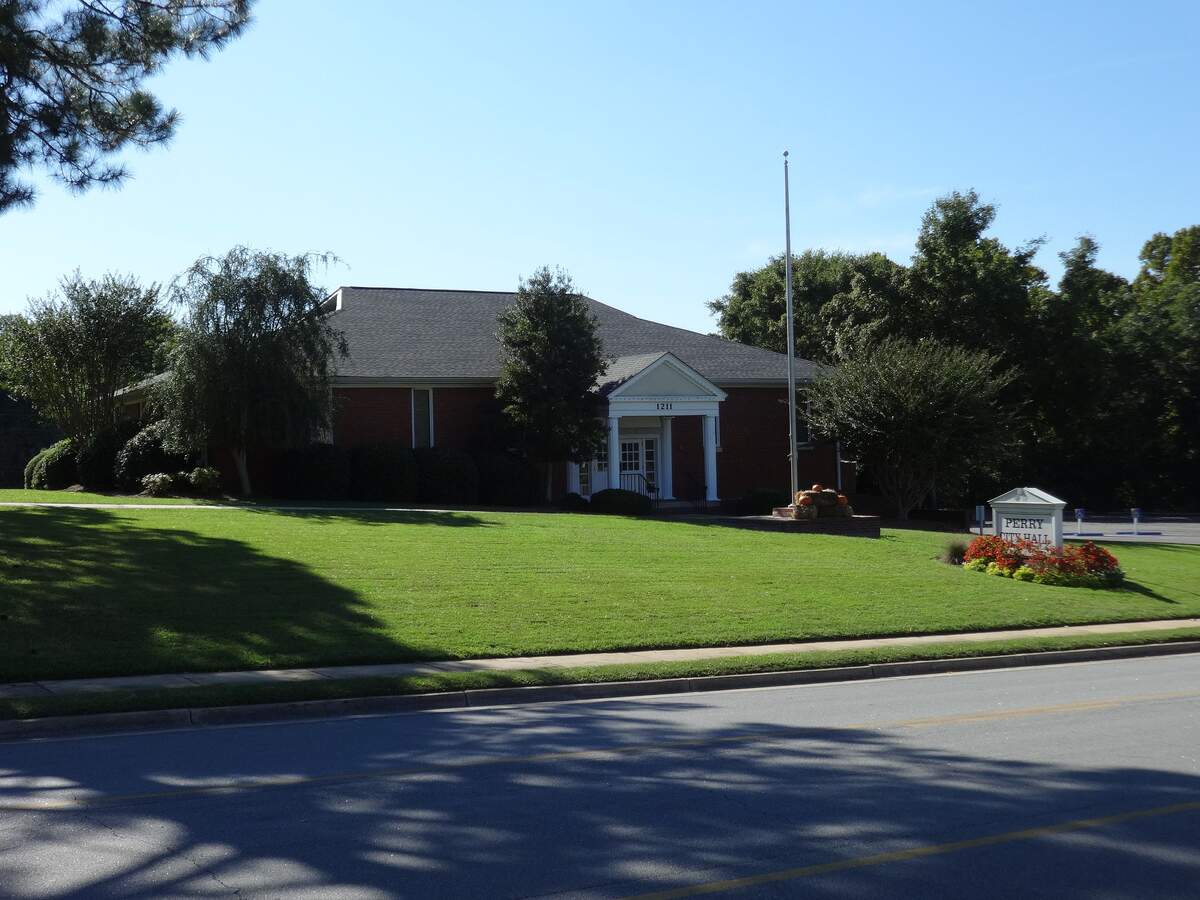
The Peach State is known for its hot summers and mild winters, where there are many sunny days. But it’s also home to millions of trees, with Atlanta earning the nickname of “city in a forest.” That means a lot of shade. If you have a shady lawn with lots of sprawling trees, you’ll need to plant the best grass for shade in Georgia.
While shade might be a welcome respite for you and your family on hot summer days, too much shade can be bad for your grass. Some grass types won’t grow as vibrantly with lots of shade, and some won’t grow at all. So, before you plant a new lawn, learn about the most shade-tolerant grasses that grow in Georgia.
Cool-Season Grasses for Shade in Georgia
Cool-season grasses are well-adapted to extreme temperature fluctuations, making them ideal for North Georgia. They grow mostly during the spring and fall when air temperatures are between 60 to 75 degrees Fahrenheit. Because they prefer cool weather, cool-season grasses are generally better at growing in the shade than other grass types.
If you live in North Georgia, where cool-season grasses thrive, and you have a shady lawn, consider one of the most shade-tolerant cool-season grasses, which include:
Fine Fescue
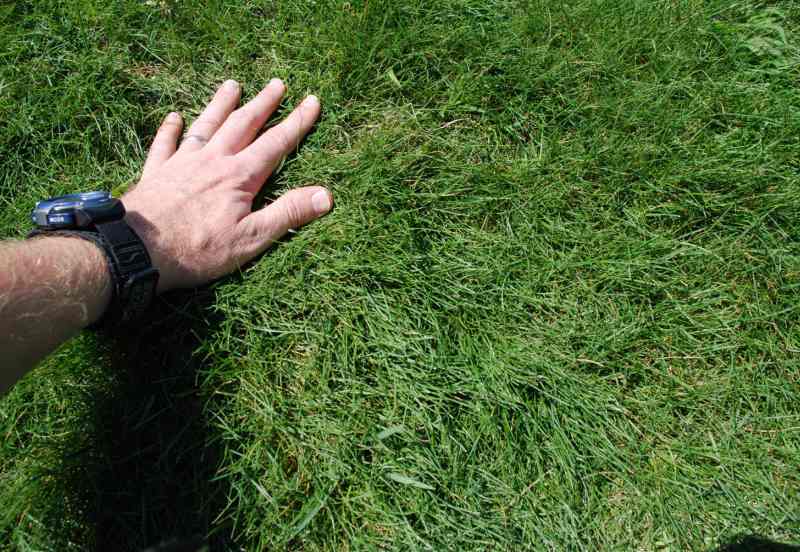
Photo Credit: Aaron Patton / Purdue’s Turfgrass Science Program
Fine fescues are best adapted to the mountainous regions of Georgia. This grass type has very good cold tolerance, so it is a great match for Blue Ridge, the coldest region of the state.
Fine fescue and turf-type tall fescue grass are often confused. Tall fescue has wider leaf blades. Although it is better adapted to the Georgia climate than fine fescue, tall fescue only has moderate shade tolerance, among other disadvantages.
Fine fescues, on the other hand, grow better in shaded conditions. Sheep’s fescue, red fescue, and hard fescue are the best fine fescue varieties for low maintenance and shaded areas. Because of the pros and cons of fine fescues for Georgia, they are typically sold in seed mixtures that include other grass types rather than on their own.
Classification: Cool-season grass
Spreads by: Creeping red fescue spreads by rhizomes, while other fine fescues are bunch-type grasses, such as chewings, hard, and sheep fescues.
Shade tolerance: Moderate to High, depending on species
Drought tolerance: Moderate to High, depending on species
Foot traffic tolerance: Low to Moderate, depending on species
Maintenance needs: Low fertilizer and mowing needs.
Mowing height: Set mowing height between 2.5 and 4.0 inches, depending on species.
Potential for disease: Moderate. Common diseases include red thread, leaf spot, dollar spot, summer patch, and powdery mildew.
Soil pH: 6-6.5
Soil type: Will not perform well in wet soil conditions. Prefers drier soils and tolerates a wide range of soil types and fertility.
Other notes: Sheep’s fescue, red fescue, and hard fescue are best adapted to low fertility, shade, and low maintenance.
Grass Seed Options:
– Outsidepride Legacy Fine Fescue Grass Seed (5 lbs.)
– Eretz Creeping Red Fine Fescue Seed (choose your size)
– Outsidepride Creeping Red Fine Fescue Grass Seed (25 lbs.)
– Outsidepride Hard Fine Fescue Grass Seed (10 lbs.)
Perennial Ryegrass
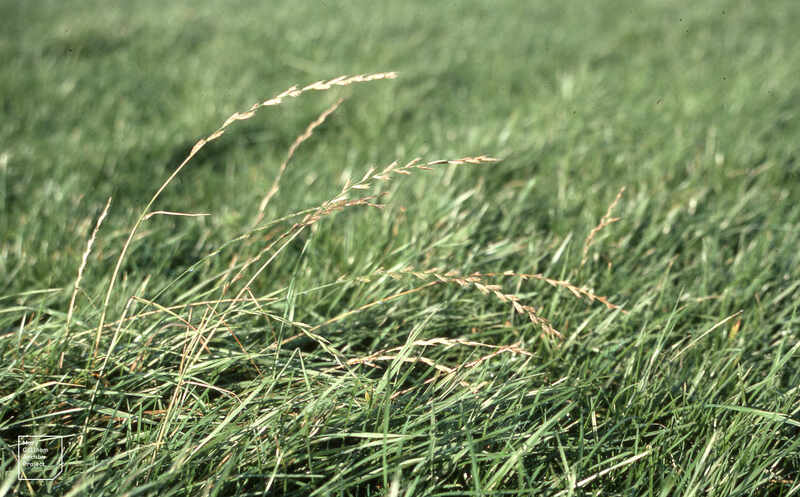
Photo Credit: Dr Mary Gillham Archive Project / Flickr / CC BY 2.0
Although the University of Georgia advises against mixing cool and warm-season grasses, perennial ryegrass can be used in Georgia over warm-season grasses that are the base or permanent grass.
Perennial ryegrass gives warm-season grasses like Zoysia and St. Augustine a protective cover in the winter when the base grass is not yet established. It gives the lawn a green cover in colder months when warm-season grasses have already gone dormant.
While perennial ryegrass isn’t as shade-tolerant as fine fescues, it can still do well with just 4 to 5 hours of sunlight per day. If you’re looking for a cool-season grass type for winter overseeding on a shady lawn, this might be a good choice for you.
Classification: Cool-season grass
Spreads by: Has a bunch-type growth habit
Shade tolerance: Moderate
Drought tolerance: Low
Foot traffic tolerance: High
Maintenance needs: Moderate mowing and fertilization requirements. Thatch is not significant.
Mowing height: Set mowing height to 1.5 to 2.5 inches
Potential for disease: High. Common diseases include gray leaf spot, red thread, and leaf spot/melting-out.
Soil pH: Can grow in soils with a pH between 5 and 8, but prefers between 6 and 7.
Soil type: Prefers good drainage and fertility, but can tolerate some poor drainage.
Other notes: In Georiga, perennial ryegrass acts as an annual. It seeds in the fall and is active and maintains a green color in the winter and spring. The extremely hot temperatures in the late spring to early summer kill perennial ryegrass.
Grass Seed Options:
– Outsidepride Perennial Ryegrass Seed (5 lbs.)
– Eretz ProTurf Perennial Ryegrass Fine Lawn Seed (choose your size)
Warm-Season Grasses for Shade in Georgia
Warm-season grasses thrive in hot, humid climates when air temperatures are between 75 and 90 degrees Fahrenheit. If you live south of Atlanta, you’ll need to choose a warm-season grass for your lawn. While warm-season grass types typically need a lot of full sun to look their best, some are more shade-tolerant than others.
For those in the warm-season grass zone, these are the best grasses for shade:
St. Augustinegrass
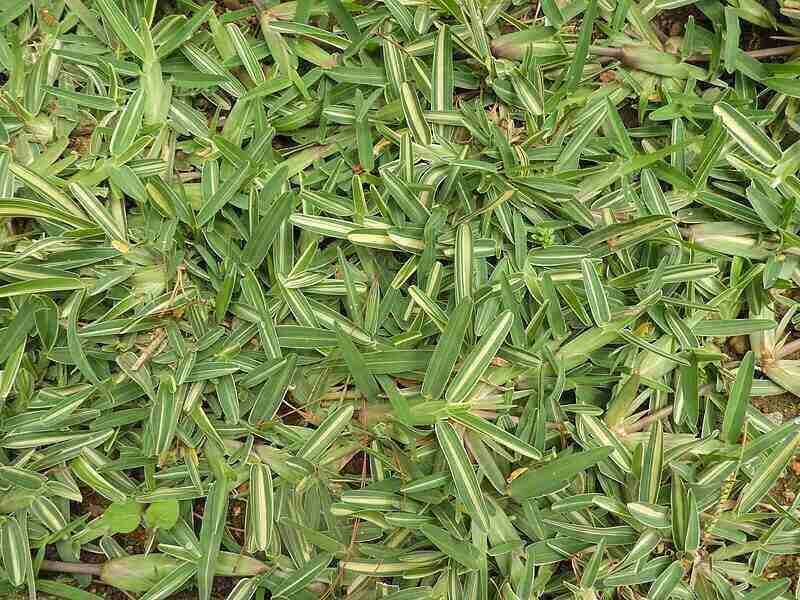
Photo Credit: Yercaud-elango / Wikimedia Commons / CC BY-SA 4.0
If you live in the Coastal Plain to Piedmont region and your property has trees or buildings that block direct sunlight, you’ll be happy to know that St. Augustine is the most shade-tolerant grass seed of all the warm-season grasses. It is best suited for Central and Southern Georgia.
In the Peach State, the cultivars Palmetto and Raleigh are available. They are adapted for both sunny and shady areas and can thrive when receiving only five to six hours of indirect sunlight daily throughout the growing season.
St. Augustine grows fast, so it is an excellent option if you want to establish a new lawn quickly. Homeowners should be mindful that winters with temperatures uncommonly low for Georgia can cause St. Augustine to recover slowly in the spring.
Classification: Warm-season grass
Spreads by: Stolons
Shade tolerance: Moderate. It is the most shade-tolerant warm-season grass, depending on the cultivar.
Drought tolerance: Moderate
Traffic tolerance: Low
Maintenance needs: High. It forms a thatch when fertilized and watered extensively; thatch can affect the grass adversely.
Recommended mowing height: Standard cultivars should be mowed at 3.5 – 4 inches. Mow dwarf cultivars at 2.5 inches.
Potential for Disease: High
Soil pH: 6-7.5
Soil type: Tolerates many soil types. Thrives best in moderately fertile and moist soils. Does not tolerate soil compaction.
Other Notes: It cannot be seeded. Vegetative means are the only way to establish St. Augustine. Sod is the most common, but sprigs and plugs are also options.
Grass Plug Options:
– Seed Ranch St Augustine Seville Grass Plugs (2 Trays)
– Seed Ranch St Augustine Floratam Grass Plugs (2 Trays)
Zoysiagrass
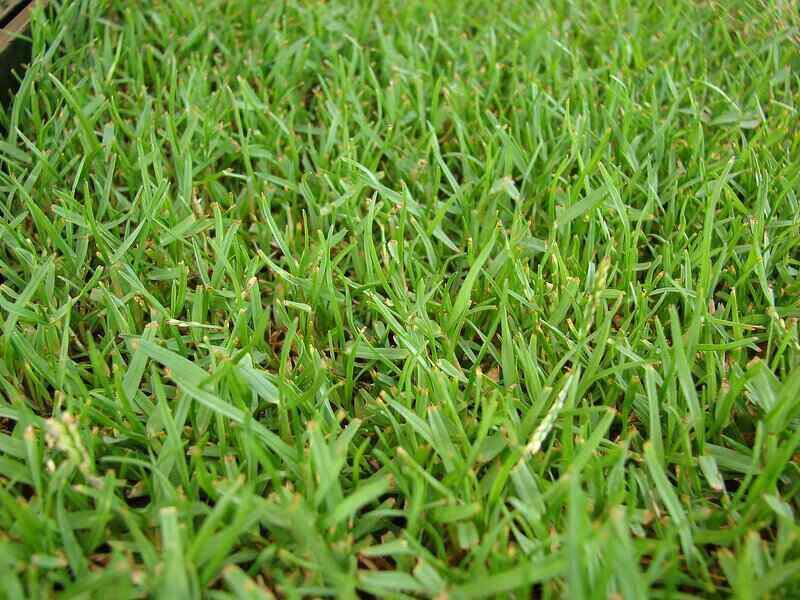
Photo Credit: Forest and Kim Starr / Wikimedia Commons / CC BY 3.0 US
Zoysiagrass grows well across the Peach State. This may be because there are multiple species and cultivars for Georgia with varying adaptation ranges. This grass type is becoming more widely used in the state.
It’s not just Georgia homeowners, however, that are partial to this type of grass. Zoysiagrass is a common choice in many commercial settings, like golf courses, parks, and sports fields because of its adaptability to many soil types and high-traffic tolerance.
Zoysia is regarded as having good to very good shade tolerance; it has some cultivars that are better adapted to shade than others. Homeowners should be aware that, even though it can tolerate some shade, Zoysia prefers full sun and grows best when it receives sunlight for at least eight hours daily.
It is also drought tolerant, which is a welcome quality in the Coastal Plain, where homeowners receive less rainfall than in the northern parts of the state.
Classification: Warm-season grass
Spreads by: Stolons and rhizomes
Shade tolerance: Moderate
Drought tolerance: Moderate
Traffic tolerance: High, but recovers slowly from damage
Maintenance needs: Moderate to High. It needs to be watered, mowed, and fertilized properly to reduce the need for pesticides. Over-fertilizing it with nitrogen can eventually produce a thick layer of thatch.
Recommended mowing height: 1 and 2 inches
Potential for Disease: Moderate
Soil pH: 6-6.5
Soil type: Thrives in well-draining soil; some cultivars are more tolerant of a wide range of soils than others
Other Notes: Zenith and Compadre are two Zoysiagrass cultivars available commercially. Both can be sodded. Meyer is an older cultivar, and it has better shade tolerance than other cultivars.
Grass Plug and Seed Options:
– Zoysia Plugs (50 Large Grass Plugs)
– Zoysia Plugs (50 Full & Lush Grass Plugs)
– Zoysia Plugs (100 Plugs)
– Zenith Zoysia Grass Seeds (1/8 lb. of seeds)
Centipedegrass
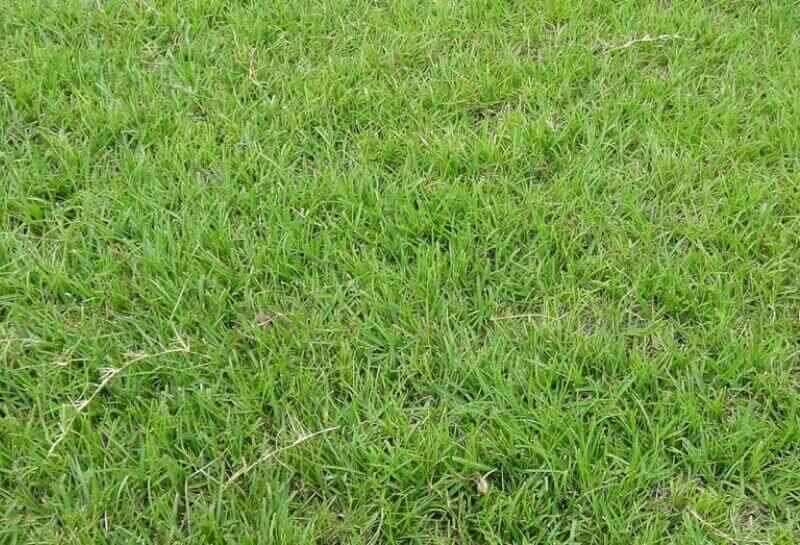
Photo credit: Michael Rivera / Wikimedia Commons / CC BY-SA 4.0
Centipedegrass is another warm-season grass that grows well in the Piedmont and Coastal Plain areas of the Peach State. Although this type of grass prefers full sun, you can have a healthy, green lawn with centipedegrass as long as it receives six hours of sunlight daily throughout the growing season. Just be sure to maintain the required fertilization and mowing heights.
TifBlair was cultivated specifically in Central Georgia and the mountains of the state to make it more cold-hardy. Like St. Augustinegrass, centipedegrass does not need full sunlight to grow well and requires only six hours of diffused or sporadic sunlight daily throughout the growing season to thrive.
A cold spell and soil temperature fluctuations in the spring can cause yellowing. The spring can also bring large patch disease. Applying fungicides can help prevent the disease.
Classification: Warm-season grass
Spreads by: Stolons
Shade tolerance: Moderate
Traffic tolerance: Low
Maintenance needs: Low (compared to other turfgrasses)
Recommended mowing height: Set the mowing height between 1 and 2 inches.
Potential for Disease: Moderate
Soil pH: 5-6
Soil type: Acidic, infertile. Performs well when there is at least moderately good drainage. (Poor results occur in very dense, clay soils.)
Other Notes: TifBlair was cultivated between Blairsville, a city located in the mountains, and Tifton, a city located in the Coastal Plain, to make it hardy enough for cold temperatures.
Grass Seed Options:
– Gulf Kist Coated Centipedegrass Seeds (1 lb.)
– Scotts EZ Seed Patch and Repair Centipedegrass (3.75 lbs.)
– TifBlair Centipedegrass (5-lb. bag)
Choosing Grass for Your Region of Georgia
Georgia stretches from the colder, mountainous Northern region to the warmer climates bordering Florida. The state of Georgia is divided into five regions:
- The Appalachian Plateau
- Ridge and Valley
- Blue Ridge
- Piedmont
- Coastal Plain
The first three regions are in North Georgia. Piedmont is in the central part of the state. Coastal Plain is the Southern region. No matter where you live, if you have the good fortune of having a property with a lot of shade to give you relief from the sunshine, you’ll want a grass that grows well in those conditions.
Each region has its own climatic conditions and planting zone, which affects which plants and grass grow best in each region. See our article on Georgia’s planting zones to learn what kind of plants are best for gardens in your part of the state. For help selecting the best grass type for your region, see our article on the best grass seed for Georgia.
FAQ About the Best Grass for Shade in Georgia
The best grass for shade in the Northern region of Georgia is fine fescue.
The best grass for shade in the Piedmont region is St. Augustinegrass.
Like the Piedmont area, St. Augustinegrass is the best grass for shade in the Coastal Plain region.
You may not have a shady property. If your home receives a lot of direct sunlight, you need grass that thrives in those conditions. The best grass types for Georgia, no matter if you’re in the Atlanta area, the mountains, or the Coastal Plain, or whether your yard is sunny or shady, are:
• Perennial Ryegrass
• Bermudagrass
• Centipedegrass
• Zoysiagrass
• Kentucky Bluegrass
• Bermudagrass
Seeding is less expensive than sodding. However, sodding can give you an instant lawn because it is just relocating established grass. If you plant grass seeds, you’ll have to wait a while for them to grow.
Fine fescue is the best shade-tolerant choice for low-maintenance grass. Centipedegrass is another low-maintenance lawn grass, and it has moderate shade tolerance for a warm-season grass.
If you’re growing a grass type in your shady lawn that doesn’t like shade, your lawn may become thin, weak, and overgrown by weeds. Weeds are a nuisance for a few reasons, one of which is their ability to outcompete grass for water and necessary nutrients. Some of the most common weeds in Georgia are:
• Bittercress
• Crabgrass
• Nutsedge
• Wild Onion
• Henbit
• Annual Bluegrass
• Goosegrass
Help Your Shady Georgia Lawn Thrive
These five grass types are the best choices for maintaining a low-maintenance, attractive lawn in the shade in Georgia. Remember to consider other conditions in your yard when choosing a grass type, too, such as soil type and average yearly temperatures.
Now that you have all you need to select grass that will thrive under the shade of a tall peach tree, you can allow someone else to mow, trim, and edge your lawn. LawnStarter can connect you with qualified lawn care professionals in your area who can keep your lawn looking great, whether it’s sunny or shady. Our pros live right in your backyard, in Atlanta, Augusta, Savannah, Macon, Athens, and everywhere else in Georgia.
LawnStarter participates in the Amazon Services LLC Associates Program, an affiliate advertising program. LawnStarter may earn revenue from products promoted in this article.
Main Image Credit: Michael Rivera / Wikimedia Commons / CC BY-SA 4.0